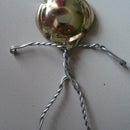Introduction: Japanese 'Zen' Table
This is what I made for my school woodwork project a while ago.
It is a small table that the top lifts off to show a compartment, which is to be filled with sand like those Japanese gardens.
I had a workshop with quite a few tools that your average household probably won't, but I am sure substitutes can be found.
This is instructable is posted "as-is" - I didn't like to have an unpublished instuctable, and wanted to share my idea.
Cheers,
Will.
Step 1: Equipment, Materials
Note: Size and shape of materials may vary, but these are the dimensions that I used, so I know they fit.
Materials:
Legs:
4x ~60cm by 10cm by 5cm
Sides:
2x 30cm by 14cm by 2-3cm
2x 60cm by 14cm by 2-3cm
Top:
1x ~50cm by ~70cm by 2-3cm (however big your table ends up being)
Inside:
1x 70cm by 50cm by ~0.5-1cm (The inner board)
2x 60cm by ~2cm by ~1cm (to hold up the inner board)
2x 30cm by ~2cm by ~1cm (also to hold up inner board)
Other stuff:
Dowel (width will depend in the side width)
Tacks/ small nails (to attach the bits that hold up the board to the sides)
PVA Glue (generally useful throughout)
Equipment:
Drill (I had a drill press as well as a horizontal drill)
Thicknesser (or this is what my teacher referred to it as) For planing the legs down, etc
Band saw - For cutting various stuff.
Circular saw - one on a table... Mainly for cutting the legs.
Some form of sander for sanding the top.
Step 2: The Basic Design
Below is the design for the table, top view and side view.
I hope this makes the overall construction easier.
Step 3: Cut the Legs, Make Them Look Nice
Using a circular saw (The type on a table) cut the legs to about 60cm each, or less, depending on the table height.
Also with the circular saw cut the side pieces. Two 60cm and two 30cm, these will attach to the legs and hold the inner board up.
Now, using a plane, thicknesser or sander, make all the wood nice.
Step 4: Drill Them
Drill two holes for the dowels in all the pieces of wood. Use picture for better guidance. For my dowel holes I did one 4cm from the top and one 10cm from the top. Make sure the holes line up, otherwise you will have to trim your dowels off later to make them fit.
Make sure you drill the holes on the right side of the legs.
Otherwise it won't fit together.
Step 5: Add Slats
On all the side pieces, draw a line 6cm from the top that spans the entire side. This will be where the inner board will rest, You may want to make it shallower or deeper.
Gather your wood strips (quality will not matter because no-one will see them) some PVA glue and small nails or tacks, and stick the strip so it is along the line, glue and nail them in place.
Step 6: Construct
To construct the table, I first put the two sets of legs with the smaller sides (Pictured below) and then added the longer sides once that had dried.
To make the Inner board, place the constructed table frame upside-down on top of your plywood board, draw an line that runs along the inside of the frame, this will be where you cut the board. Use a bandsaw or Jigsaw to cut the board, if it doesn't fit, cut a little more off.
Step 7: Table Top
Cut out a nice top for your table, it can overlap the sides if you like. Using the same outlining method, make a line around the corners, this is where you drill some holes.
The holes should touch the edge of the line, but not cross it. Glue in some dowels into these holes, and they will stop the top from sliding about.
Step 8: Finished
If you want to put sand in the table, you will need some form of sealant, I used some stuff called 'Liquid Nails' which works well.
I hope you like it, if you have any questions please ask.
Will.













